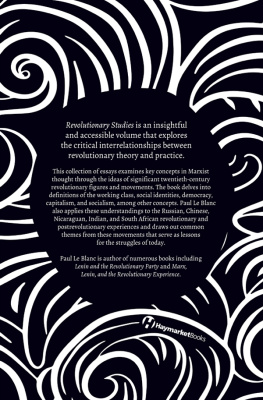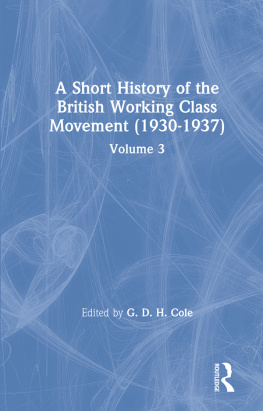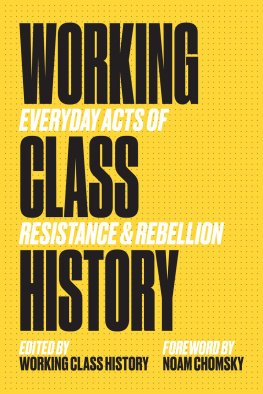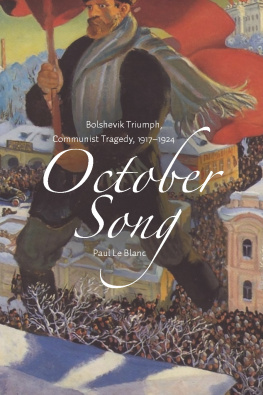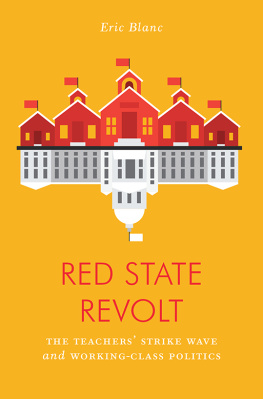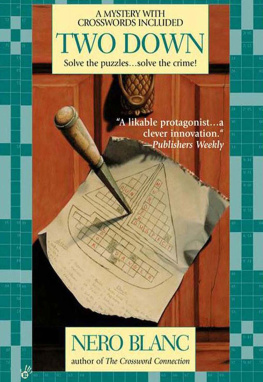A Short History
of the
U.S. Working Class
From Colonial Times
to the Twenty-First Century
Paul Le Blanc
Illustrations by
Mike Alewitz
Haymarket Books
Chicago, Illinois
Excerpt from The People, Yes by Carl Sandburg, copyright 1936 by Harcourt, Inc., and renewed 1964 by Carl Sandburg, reprinted by permission of the publisher.
1999 Paul Le Blanc
First published 1999 by Humanity Books, an imprint of Prometheus Books
This edition published in 2016 by
Haymarket Books
P.O. Box 180165
Chicago, IL 60618
773-583-7884
info@haymarketbooks.org
www.haymarketbooks.org
ISBN: 978-1-60846-669-6
Trade distribution:
In the US, Consortium Book Sales and Distribution, www.cbsd.com
In Canada, Publishers Group Canada, www.pgcbooks.ca
In the UK, Turnaround Publisher Services, www.turnaround-uk.com
All other countries, Publishers Group Worldwide, www.pgw.com
This book was published with the generous support of the Wallace Action Fund and Lannan Foundation.
Cover design by Rachel Cohen.
Library of Congress CIP data is available.
Contents
This book is dedicated to
Frank Lovell
(19131998)
one of many who has taught and inspired me.
Preface to the 2016 Edition
It is a pleasure to see a new edition of this short history of the U.S. working class made available by Haymarket Booksparticularly with a new cover that highlights the diversity of those whose lives and labor have always kept our country running. In the books introduction, I define what I mean by working class (a term I much prefer to the fuzziness of middle class )it is consistent with the recent Occupy movements notion of the 99%, which means it refers to most of us, regardless of precise percentages. The richness in composition of todays working-class majority is matched by the richness of our history, which this book seeks to convey.
At the present moment, a majority of the people in the United States seem to facein some important waysnastier realities than was the case when I was growing up. What has been made of our country and of our world, by those whose power and policies have been dominant, is shameful and outrageous and horrific. Growing numbers of people are becoming fearful, angry, and restive over this state of affairs, with a sense that things should be better than they are. This book helps to show how laboring people in the past faced similar hard times, and through solidarity and struggle they brought about many positive changes in their lives. Some of these changes are still of benefit to us today.
There is much that has happened since the first appearance of this book. Rather than attempting a fifteen-year update, we can put it quite simply: The situation of the broadly defined U.S. working class is worse in 2016 than it was in 1999. Yet there are also new strengths coming to the fore. Surveying the rich diversity of race and ethnicity that makes up our working-class majority, Martin Luther King Jr. commented back in the 1960s: We may have all come on different ships, but were in the same boat now. This elemental understanding is shared more widely today than was the case back then, and there has also been, in our society, the deepened awareness that great social changes are impossible without the feminine ferment (as Karl Marx once noted). There are still, of course, powerful forces at work to set us against each other, but as the labor radicals of the old Industrial Workers of the World pointed out: An injury to one is an injury to all. The organized labor movement has seen better days, to put it mildly. But what doesnt kill us makes us stronger. History shows that hard times, sooner or later, generate hard-fought struggles through which were capable of winning victories and bringing better times.
It is my belief that we can learn from the past in order to shape a better future. In striving to make this so, we must draw from the inspiring vision, the great underlying spirit, that animated some of labors greatest spokespeople (some of whose names are unknown), who spoke and wrote and sang about a better world of freedom, truly creative labor, and genuine community that can and must be won for all of us. Elements from such speeches and writings and songs pepper these pages.
In the first edition of this book, I foolishly, absent-mindedly left out a song that has inspired many, and may inspire many more. It grew out of the great Lawrence, Massachusetts, textile strike of 1912, described in these pages. Women played a central role in that hard-fought but successful struggle, and for some this threw into bold relief the passion and strength of the half of humanity whose liberation from oppression is pivotal to the liberation of all. The radical poet James Oppenheim captured that revolutionary spirit in his poem Bread and Roses. My failure to include it earlier enables me to share it now as the conclusion of this new preface.
As we come marching, marching in the beauty of the day,
A million darkened kitchens, a thousand mill lofts gray,
Are touched with all the radiance that a sudden sun discloses,
For the people hear us singing: Bread and roses! Bread and roses!
As we come marching, marching, we battle too for men,
For they are womens children, and we mother them again.
Our lives shall not be sweated from birth until life closes;
Hearts starve as well as bodies; give us bread, but give us roses!
As we come marching, marching, unnumbered women dead
Go crying through our singing their ancient cry for bread.
Small art and love and beauty their drudging spirits knew.
Yes, it is bread we fight forbut we fight for roses, too!
As we come marching, marching, we bring the greater days.
The rising of the women means the rising of the race.
No more the drudge and idlerten that toil where one reposes,
But a sharing of lifes glories: Bread and roses! Bread and roses!
Preface
In part, this book has its origins in my origins. Growing up in the small Pennsylvania town of Clearfield, in the 1950s and early 1960s, I learned from my father and mother, Gaston Le Blanc and Shirley Harris Le Blanc, to have a reverence for the labor movement (the organizations of the working class, especially unions), with which they had identified and which they had been part of for many years. My father worked for the United Stone and Allied Products Workers of America, AFL-CIO/CLC (though he had started off in the Unemployed Councils and Workers Alliance of the 1930s); my mother had worked for the United Electrical, Radio and Machine Workers of America (CIO) in the mid-1940s, and after my birth had also done some part-time work for various unions, including the Stoneworkers and the Amalgamated Clothing Workers of America, AFL-CIO. They were mainstays in Clearfields central labor council. Among my earliest childhood memories are union meetings, picket lines, and Labor Day parades.
The coherence of the past, the meaning of the present, the hope for the futurefor all of these things the labor movement was a central reference point. A union for them, and for me, meant what the word implies: the coming-together, the shared strength, of the workers. I was taught that the workers joined together to struggle against the rich, powerful, selfish employers who exploited them. Through unions they sought dignity, decent wages and working conditions, a better future. (I think they would have appreciated the pugnacious insight voiced by Martin Glaberman and Seymour Faber: Unions dont organize workersworkers organize unions.) I was taught labor songs, such as Solidarity Forever and Union Maid, which sometimes the whole family (there were also my sisters, Patty and Nora) would sing to break the tedium of a long car ride, invariably lifting our spirits with a melodic and poetic visionexpressed with spunk and humor and determinationof labors inspiring cause.







